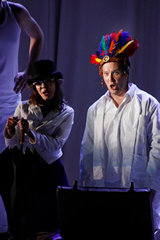| Opera Articles | 26 April 2024 |
| The 'Tingle' Factor: what makes a winning voice? | |
| A new production of Mozart's The Magic Flute by Co-Opera
Co. may help researchers design more appealing artificial voices. |
|
|
Dr Christopher Newell conceived the project after a discussion with Professor David Howard, an international expert in synthetic speech and singing. Howard was researching the properties of sounds produced by child soloists that elicit the so-called 'tingle' factor, to aid understanding of children's voice development and to provide additional data for creating an electronic voice. Newell and Professor Peter Wright at the Culture Lab at Newcastle University assembled an interdisciplinary team consisting of DR Tuck Leong (a design researcher), Gill Main (a singing and voice specialist) and DR Darren Reed (a sociologist) to develop the idea into an exploratory study with an opera company. Serendipitously, Newell was preparing to direct Mozart's The Magic Flute for CO-Opera Co. and he approached them to see if they would allow the team to wire up members of the opera audience with Wii-style vibration detectors, to find out if and when they 'tingled' during the performance. The research team were interested in whether the 'tingle' factor could be planned and prepared for by the opera's creative team, anticipated by the audience members, and whether any consensus could be reached in the identification of 'tingles' within the performance. |
|
|
However, there was also an interesting divergence: some singers asserted that they only experienced 'tingle' when observing a performance - whether as a member of the audience or, while on-stage, when listening to another singer - while a few maintained that 'tingle' could also be experienced while they themselves performed. Singers were also asked to comment on what they believe to be the potential 'tingle' moments in The Magic Flute, and how they thought they might achieve them during performance. Pointing to particular moments of the opera, they spoke about the need to 'inhabit' the role, particular vocal techniques they hoped to put in place to achieve certain musical effects and expression, and the importance of being 'lost in the moment' and being able to sing effortlessly without appearing to focus on technique. The research team also aimed to measure the 'tingle' factor more scientifically. During the first two public performances of The Magic Flute, in addition to surveying various audience members before and after the performance about their experiences of the 'tingle' factor, the team used motion detectors to try and capture these audience members' behaviour during the performance. The idea was to try and see if a particular physical movement correlated to particular moments during the opera. Each participant was given a motion detector (hidden in a locket) to wear around his or her neck. This locket also had a vibrating button that they could press if they felt that they were 'tingled' during the performance. Finally, a motion detector was also attached to the back of each participant's chair. Together, the research team hope that these measures will not only reveal whether these particular audience members were 'tingled' but also if these 'tingles' align with what was planned by the production team. The data from this part of the study is still being analysed; at this early stage, the results are not expected to reveal an algorithm for producing 'tingle'. 'Tingle' is significantly harder to define than 'intelligibility,' 'naturalness' or whether the artificial voice has a convincing regional accent (often a high priority for people who are required to use these technologies). However, the team hope that the results from the motion detector data will go some way to showing that 'tingle' is detectable, measurable and perceptually very important. This could contribute to a more holistic approach to the design of artificial voices. Photos: Contributors: This work was supported in part by the Research Councils UK Digital
Economy Programme [grant number EP/G066019/1 - SIDE: Social Inclusion
through the Digital Economy] |
|
| © Christopher Newell |

 The expressive voices of opera singers may seem far removed from the
robotic tones of Professor Stephen Hawking, but a team of UK-based researchers
from the University of Hull, Newcastle University and the University
of York thinks one can help us improve the other. While, for the most
part, the artificial voices of today are clear and intelligible, getting
people to like (or even tolerate) them remains a big problem, particularly
for users like Professor Hawking, who have no choice but to use them.
Understanding what makes the hairs on the back of your neck stand up
during an operatic aria -the 'tingle' factor - may help designers produce
more attractive artificial voices for use in more realistic contexts.
The expressive voices of opera singers may seem far removed from the
robotic tones of Professor Stephen Hawking, but a team of UK-based researchers
from the University of Hull, Newcastle University and the University
of York thinks one can help us improve the other. While, for the most
part, the artificial voices of today are clear and intelligible, getting
people to like (or even tolerate) them remains a big problem, particularly
for users like Professor Hawking, who have no choice but to use them.
Understanding what makes the hairs on the back of your neck stand up
during an operatic aria -the 'tingle' factor - may help designers produce
more attractive artificial voices for use in more realistic contexts.
 The
study took place at the end of August 2011. Prior to the staged performance
of The Magic Flute, Leong and Main interviewed some of the singers
during rehearsals to explore their understanding of the 'tingle' factor;
the preliminary findings reveal that all interviewed claimed that they
had encountered this phenomenon during performances. Such moments were
described as being deeply engaging: participants described their surroundings
seemingly fading away, or a sensation of time slowing down, as well
as physical manifestations of 'tingle,' such as goose bumps or shivers
The degree of this experience varied depending on the occasion but commonly,
'tingle' appeared to arise when a person was able to find a personally
meaningful connection with what was happening on stage. This could be
a connection to various elements of the music, the plot, the quality
of the vocal performance, or combinations of these factors. Surprise
and unexpectedness could also contribute to 'tingle' moments, such as
an unexpectedly beautiful rendition of an aria or a pyrotechnic performance.
Closely related to this was a perception that the performance was 'genuine,'
'authentic' and 'honest' - qualities that aroused admiration and stirred
empathy.
The
study took place at the end of August 2011. Prior to the staged performance
of The Magic Flute, Leong and Main interviewed some of the singers
during rehearsals to explore their understanding of the 'tingle' factor;
the preliminary findings reveal that all interviewed claimed that they
had encountered this phenomenon during performances. Such moments were
described as being deeply engaging: participants described their surroundings
seemingly fading away, or a sensation of time slowing down, as well
as physical manifestations of 'tingle,' such as goose bumps or shivers
The degree of this experience varied depending on the occasion but commonly,
'tingle' appeared to arise when a person was able to find a personally
meaningful connection with what was happening on stage. This could be
a connection to various elements of the music, the plot, the quality
of the vocal performance, or combinations of these factors. Surprise
and unexpectedness could also contribute to 'tingle' moments, such as
an unexpectedly beautiful rendition of an aria or a pyrotechnic performance.
Closely related to this was a perception that the performance was 'genuine,'
'authentic' and 'honest' - qualities that aroused admiration and stirred
empathy. 






